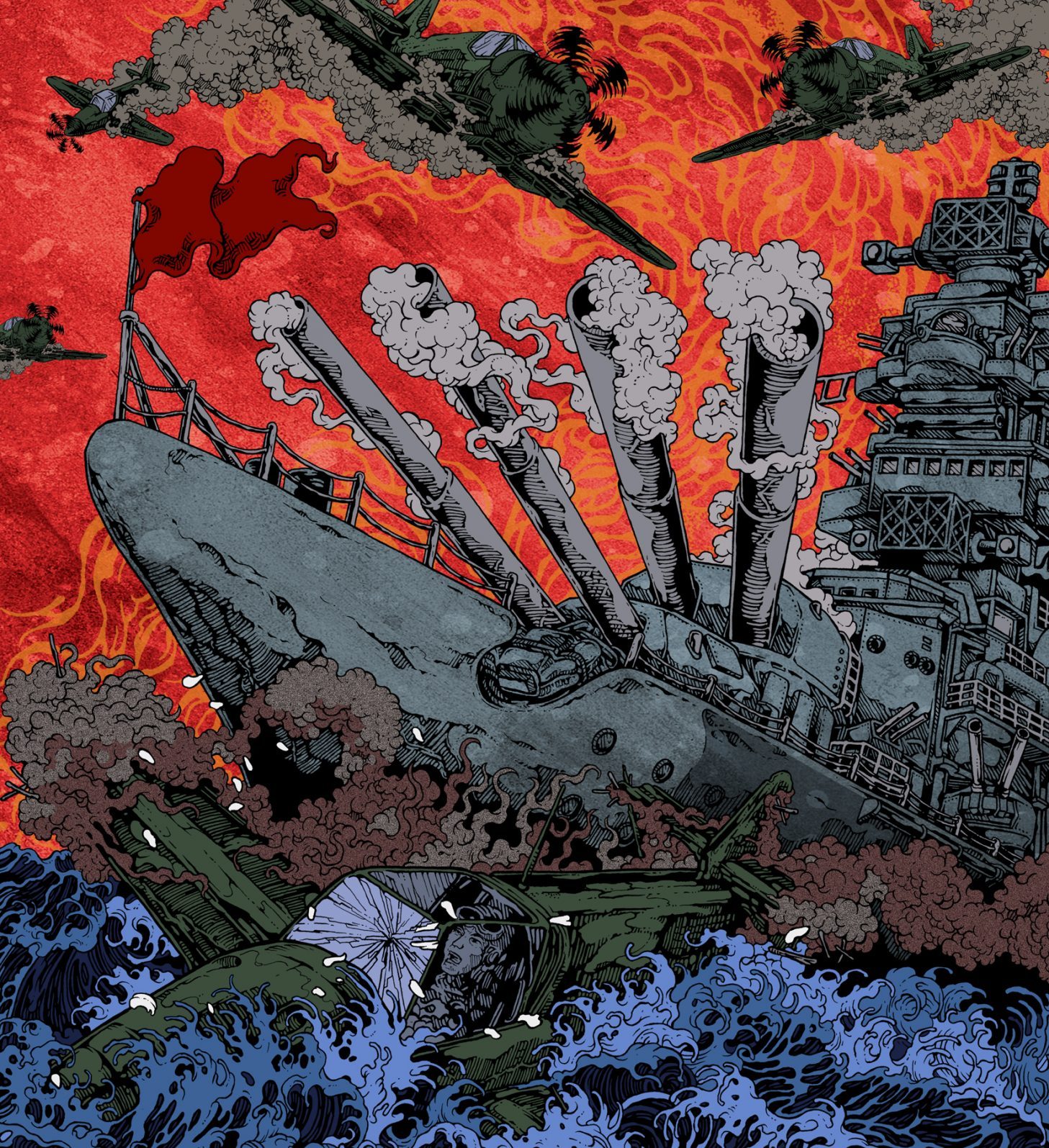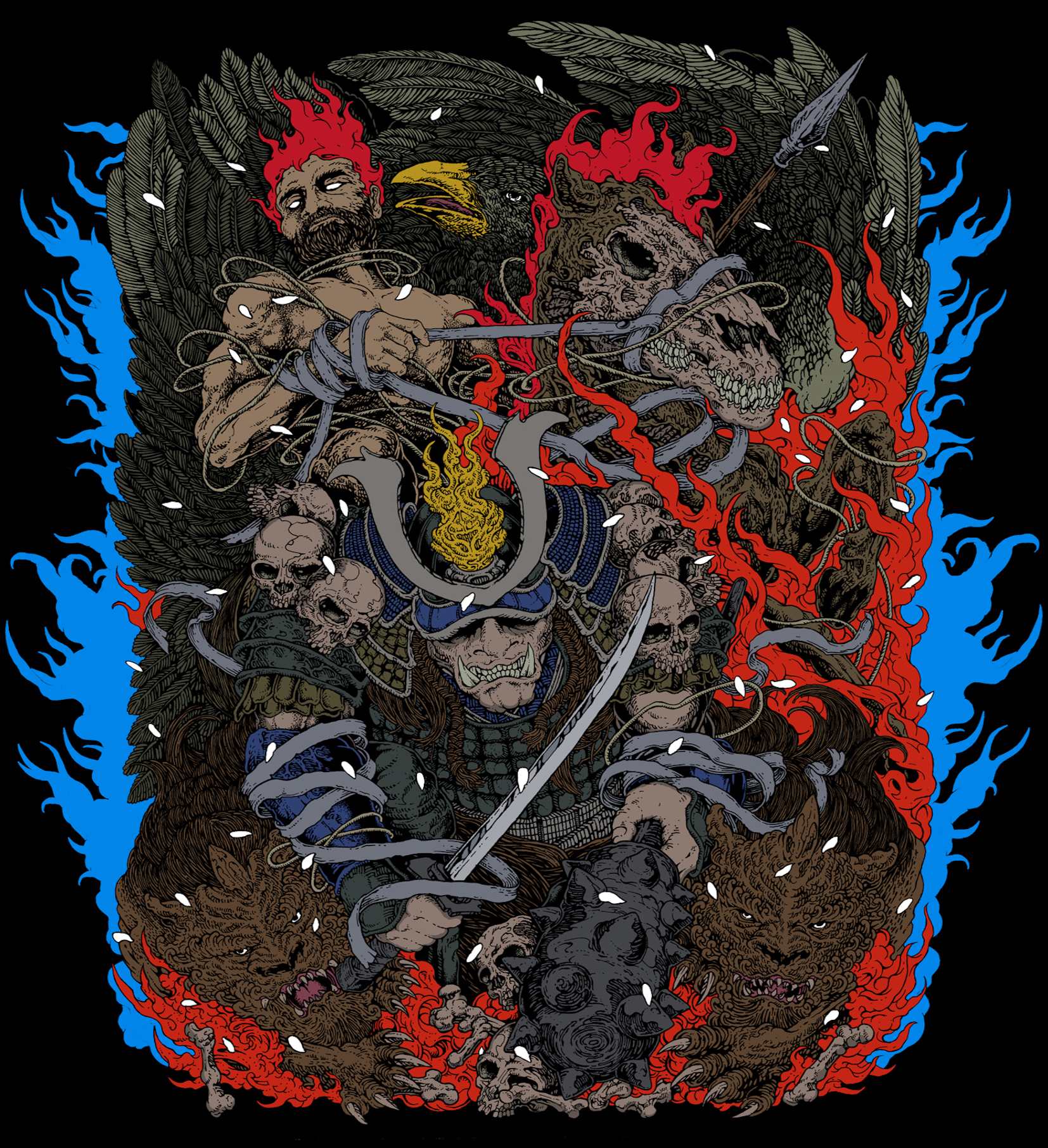
Anggareza Adhitya. Born and grew up in Bandung, Anggarez – by which you might know him better – has been passionate about drawing since his early age. The path that led him to Arts & Design was paved by his teenage interests: music and skateboarding. After finishing his study in Faculty of Arts and Design (FSRD), Institut Teknologi Bandung, Angga moved to Jakarta to pursue his career in creative industry. He started as a Graphic Designer and stepped up to Art Director post until now. In 2013, while fulfilling his duties in an advertising agency, Angga started his part time projects as an illustrator, mostly for album covers or merch for bands – Seringai, Taring, Kelelawar Malam, Matiasu, to name a few – or clothing brands.
As displayed in his artworks, Angga likes to explore some techniques in his illustration, mostly manual drawing, ink on paper and water color. His preferred style is semi-realistic with lines, blocking, cross hatching, and pointillism. –

Despite the digitalized world we’re living now, Anggarez holds to his belief in preserving originality of an artwork by choosing more of a manual or traditional method of drawing. His long-term mission is to be able to express his thoughts and interest through his artworks and by doing so, preserving the life of the creative industry. In his spare time, Angga always tries to spend some time in one of his hobbies: cycling. In addition to doing it as a physical leisure, cycling is essential for him to serve as a health foundation to support his busy times as an art professional.
For this collaboration, called ‘THE HUSTLE’, Anggarez manually drew – initially, literally ink on paper – twigs and bones collected, mixedly arranged into a stack. The shapes represent his working-life pattern that is hectic, overlapping and requires multi-tasking. The bones symbolize strength, the quite indestructible, last earthly traces of living being, while the twigs represent flexibility, growth and resilience. Having two different elements in a stack require passion and focus to turn the seemingly entangled character into a matured pattern.
Interested in knowing Anggarez better? Here’s our little chat with the Artist.
From music to skateboard then to illustration. How did that happen?
As a teenager who already had an interest in arts, I would spontaneously be able to see lots of intriguing things to absorb, such as graphics arts on my favorite skate board, on clothing, on album covers, on music merch and many other objects. Those things gave me stimulation to find out what culture it represents, who the artists are, what the industries behind it are like, digging up its relevant information and then appreciate those things up until the point where I tried to make/involve in the above mentioned subject.
You have a formal background in Arts, what are the advantages so far?
The utmost advantage is to be able to learn the basics of Arts correctly from the experts, seniors, lecturers and professionals, in terms of both technicalities and knowledge, so that I can use it as a foundation and provision to undergo a life as an artist until now.
Deciding to choose semi-realistic style, was it a result of a journey or did it happen just like that?
Seems like the style has been pretty much my favorite since I was a teen, since there was actually a process that shaped my interest in creating shapes with certain details. And by the time goes, along with absorbing much from different references, I become more and more convinced with that choice of style.
You feature a lot of skulls, skeletons, or surreal things in your illustrations. Do they symbolize something to you?
My interest in choosing those objects emerged firstly from my teenage, triggered by my hobby in appreciating music and sub-cultures embedded around rock music, whose genres are mostly indie, punk, hardcore, heavy metal and alike, and also the influence from the 90’s skateboard graphic such as Powell Peralta, Santa Cruz, Zorlac, and such. Incidentally, those characters become the icons and symbols of my personal view and feelings towards a fight or dissatisfaction or sometimes it simply tends to be a visual device for my imaginations. One of the fights I mean here can be viewed as an intention to display unfamiliar shapes, the dark and the fierce, the unpopular culture or less normal in general, to be an acceptable visual aesthetics.
How do you get the inspirations for an illustration in a commissioned project?
For this sense, I learn in a way from creative skills in advertising agency. In addition to depending on imaginations to get inspirations, it is also important to note that in a work brief, there is always the objectives points and level of priority. There is also an understanding about who the client is, their background and the history. However, in the field of illustration, the levels and the portions of those points are relatively more relaxed and playful.
Artists or Art Period that influence you the most?
International artists such as Pushead, Pettibon, and VC Johnson have been my role models since the 90s. Along with my starting to draw, I got more insights, so I found other role models, such as Beckett, Baizley, Horkey, Bernie Wrightson, Dore, Dean and many more. The most influencing period is when I started to have interests towards album covers and illustration for merchandise, back when illustration and drawing were done manually.
Producing quite a lot of illustrations for merchandise, both for personal and commissioned projects, are there any unique experiences in the process?
The experience of creative process would be different when it is done for personal project, collaboration or commissioned work; yet it sparks the same joy when I see the merchandise is being used by someone. The most memorable experience is probably when I produce t-shirts with my own designs on it. That’s because i really enjoy the process, from the initial sketch, the t-shirt has materialized, up to packing and sending that I did on my own, DIY, and everything was sold out in a week.
Why did you agree to do collaboration with MCC?
For the following reasons ;
- I would do collaboration with as many brands as possible
- I like cycling
- Cycling caps are interesting medium
- And certainly to extend friendships
Can you tell us a little about the story behind the illustration in this collabs?
I think this collab is very interesting because it can serve as a bridge for me to go across to the area/level I’ve nerver explored before.
Visually, this artwork was inspired from a day-to-day life at that time; the time when I found out that I would do collaboration with MCC. Also added to the factor is my status as an employee in an advertising agency, which gave its portion to which artwork shape choice I would present in this collaboration.
Originally, this artwork is an ink drawing on paper which shows a visual of shapes of bones and twigs, collected, stacked, mixed and seems to be unstructured, which is then reworked into a pattern. I personally think that some patterns are getting too common, thus I tried to make a signature pattern with my own style. As a shape, it is flexible. As a character, it has a thread, and it relatively took shorter time than usual for me to finish. This pattern symbolizes my working life pattern that is pretty hectic and multi tasking, though I always tried to focus and be flexible.
Technically, what I want to illustrate here is a matter of adaptability and flexibility, that the detailed objects I have been many times visualized on paper can actually be applied into accessories that can be used in general. Everything is just a matter of what the shape is and how we shape it.
For you personally, does cycling have significant part in your creative process?
Certainly, and this collabs with Mujiono CC is one of them. Choosing to ride a bike or doing something else as a hobby actually depends on our preference. The point is, not only in terms of cycling, in every hobby that I took up, there is always a room for me to be motivated into doing something artistic and creative. For me personally, all of the creating and working process must start from a physical fitness. Cycling gives me enough support to continue working with enthusiasm. A side story, I have taken a liking to non-competitive cycling since I was in elementary, junior high and high school. Before I enjoyed skateboarding, I used to like freestyle BMX. I quit because I fell and I broke my left arm. For several years, from junior high to first grade of high school, I rode a bike to school almost every day. So roughly, cycling has been giving quite a lot of positive impacts in my life so far.
Do you have any riding plans that haven’t been realized yet?
I once had a thought of cycling out of town, like to Bali or Yogya, which would have been cool. But seeing my working pattern as a professional in arts, it takes quite a lot of my time. So, weekend ride once a week has been quite entertaining for the time being hahaha, maybe when I can really spend some time and be able to plan really carefully, I would try riding out of Jakarta.



